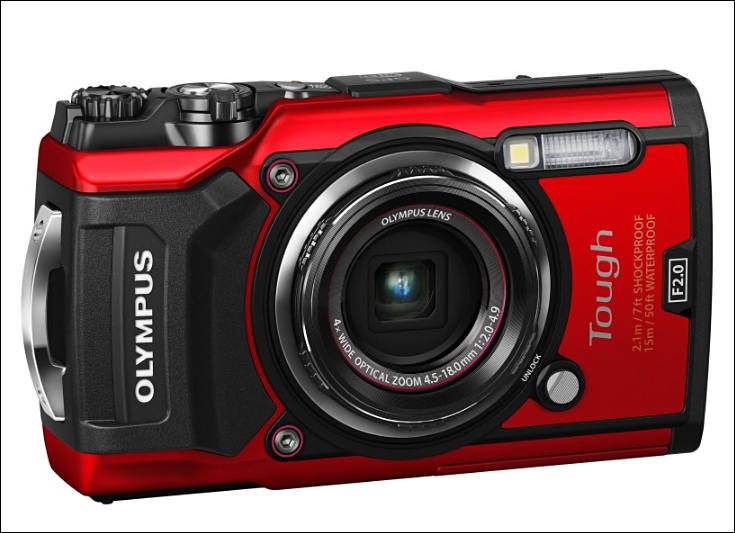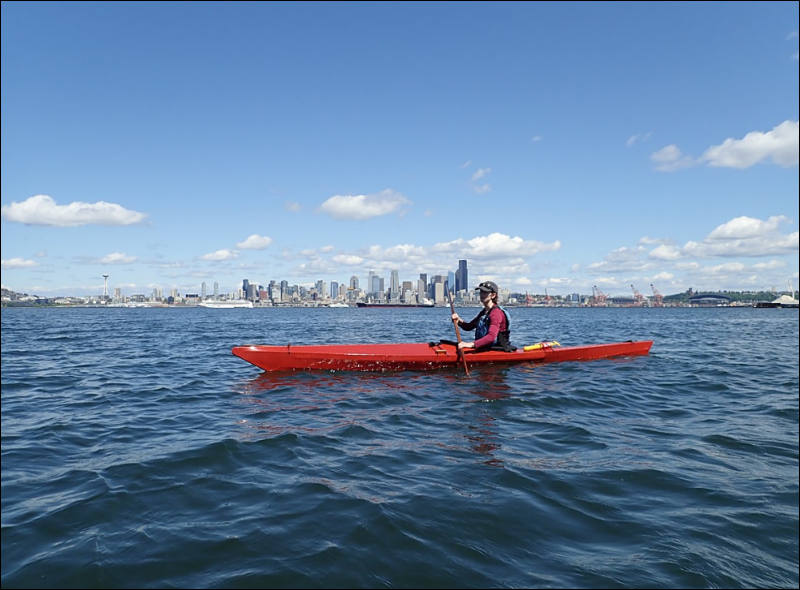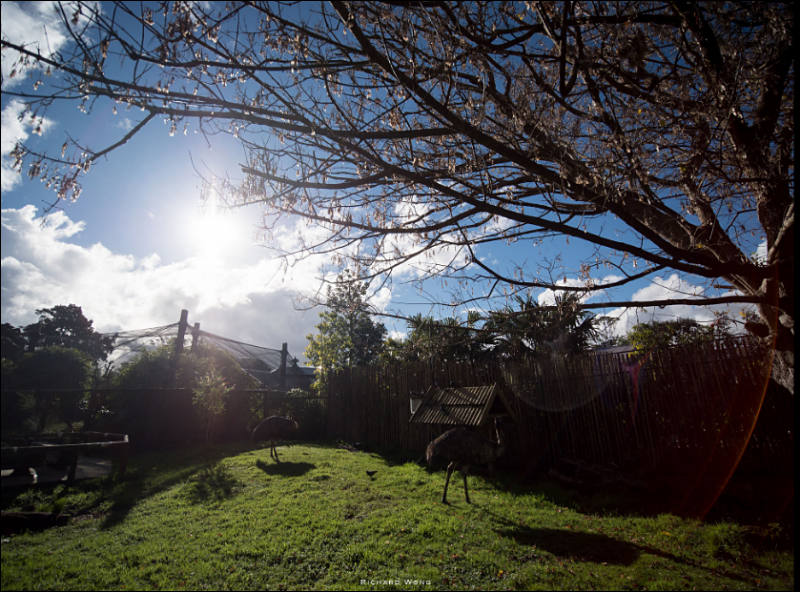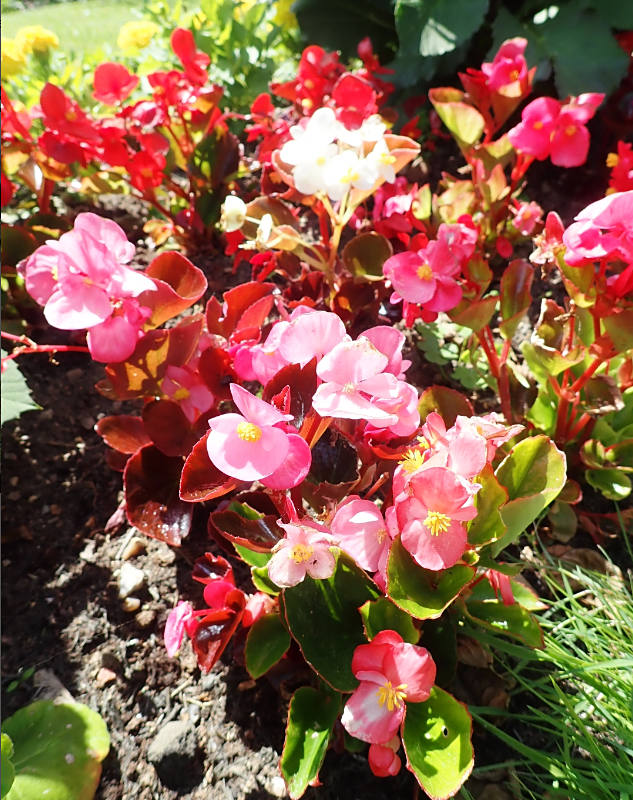
-

- High-speed f2.0 lens with a 25–100mm focal length
- New high-performance BSI CMOS image sensor
- Latest high-speed TruePic VIII Image Processor
- Available for $449 from https://www.amazon.com/Olympus-Waterproof-Camera-3-Inch-V104190RU000/dp/B071RSJGXZ/
-
PR
Olympus builds on the outdoor shooting and tracking capabilities of the Tough product family with the new Tough TG-5, a compact digital camera designed to capture outstanding images in the most challenging conditions. The Tough TG-5 combines its high-speed f2.0 lens with advanced technologies, including a new high-performance backlit 12-megapixel CMOS image sensor, Olympus’ latest high-speed TruePic VIII Image Processor and a Field Sensor System that records movement and environmental data. With the Tough TG-5, users are able to tell immersive stories using brilliant videos, stills and data captured from their extreme adventures.
The new Olympus Tough® TG-5 touts the widely praised bright f2.0 lens found on previous premium Tough models. Boasting a wide-angle 25mm to a telephoto 100mm (35mm equivalent) focal length, this lens works in concert with the new high-speed backlit CMOS image sensor and the dual quad core TruePic VIII Image Processor to deliver the highest image quality of any Tough model to date.
The built-in Field Sensor System, consisting of a GPS sensor, manometer, compass and temperature sensor, records movement and environmental data independently or in conjunction with still images or videos. Data logs can be simultaneously displayed with images and videos using the Olympus® Image Track app, enhancing the experience of reliving and sharing outdoor adventures.
The Tough TG-5 excels in extreme conditions. In addition to being waterproof to 50 feet (15 meters), crushproof to 220 pounds of force (100 kilograms of force), shockproof from 7 feet (2.1 meters), freezeproof down to 14°F (-10°C) and dustproof, the camera now includes Anti-Fog Lens Cover Glass. This allows the Tough TG-5 to capture amazing action shots on the slopes, underwater and in other uniquely challenging environments where other cameras can’t perform.
New video functions include 4K Movie to capture Ultra HD video at four times the resolution of Full HD, allowing users to record beautiful scenery in amazing detail. Full HD 120fps High-Speed Movie lets users easily capture stunning slow-motion, and 4K Time Lapse automatically creates short videos of long periods of time.
Pricing and Availability
The Olympus Stylus Tough TG-5 will be available in red and black beginning in June 2017 with an estimated street price of $449.99 USD and $579.99 CAD. For a complete list of specifications, visit the Olympus website: getolympus.com/digitalcameras/tough/tg-5.html.
-
Main Features
High-speed f2.0 lens, new high-performance BSI CMOS image sensor and the latest high-speed TruePic VIII Image Processor deliver high-quality images in all lighting conditions.
The high-speed lens works in concert with the image sensor and processor for a powerful synergy resulting in improved high-quality images, even in low light or underwater.
High-performance BSI CMOS image sensor and the latest TruePic VIII Image Processor
The Tough TG-5 features a high-speed f2.0 lens, a newly developed high-sensitivity, high-speed backlit 12-megapixel CMOS image sensor and the latest TruePic VIII Image Processor used in the Olympus flagship OM-D E-M1® Mark II camera. The new technology produces better image quality at standard and higher sensitivity ranges. The processor is capable of more complex calculations to improve resolution in low-contrast areas, especially when shooting at low ISO sensitivity. A maximum ISO sensitivity of 12800 and RAW capture are also available, covering a wide range of shooting situations.High-speed f2.0 lens with a 25–100mm focal length (35mm equivalent)
The bright f2.0 lens supports faster shutter speeds when shooting underwater or in other challenging conditions to capture fast-moving subjects with minimal blurring. Superb Olympus optical technology is incorporated into the lens, including DSA (Dual Super Aspherical), HD (High Dispersion) and HR (High Refractive Index) lenses to deliver high-quality images while reducing aberrations throughout the entire zoom range.Field Sensor System adds tracking data to images and videos for reliving the moment.
The Tough TG-5’s Field Sensor System consists of built-in sensors, including GPS, a compass, a temperature sensor and a manometer for altitude or depth. Tracking data may be recorded simultaneously with images and video or independently using the camera’s Data Log Mode. Tracking data may be viewed on the camera’s monitor or on a smart device. Users are able to press the INFO button to display current real-time data, even when the camera is turned off. Using the Olympus Image Track app to simultaneously display images, videos, and tracking information, lets users tell the story behind their shots.
Field Sensor System
- GPS: The built-in GPS utilizes GLONASS and QZSS satellite systems in order to precisely calculate latitude and longitude. The GPS Assist function significantly reduces the amount of time required for initial GPS signal acquisition.
- Manometer: Altitude and water depth are calculated based on atmospheric pressure and water pressure information.
- Temperature Sensor: This sensor measures both air and water temperature, and is shielded from the effects of heat generated inside the camera.
- Compass: The compass measures the direction in which the camera lens is pointed.
Olympus Image Track App
Pairing the camera and a smartphone with the TG-5’s built-in Wi-Fi® enables the simultaneous display of images, video, and tracking information, delivering a unique way to relive users’ experiences. A data overlay can be applied to images or video for posting adventures to social media. The resizing of images and videos is also available with the app.
Reliable Tough performance: waterproof to depths of 50 feet (15 meters), shockproof from 7 feet (2.1 meters), crushproof to 220 pounds of force (100 kilograms of force), freezeproof down to 14°F (-10°C), dustproof and Anti-Fog Lens Cover Glass.
Hermetically sealed construction provides waterproof performance for worry-free shooting underwater. This sealing also provides superb dustproof performance so that users can feel comfortable using the camera in dusty and dirty environments. The Tough TG-5’s shockproof performance is made possible via its floating construction that suspends key components inside the housing of the camera, enabling the camera to clear drop tests of up to 7 feet. The Tough TG-5’s robust construction also withstands loads of up to 220 pounds of force. Reliable operation is assured down to 14°F, making it possible to use the camera in cold environments where other digital devices may fail. In addition, the Tough TG-5 features Dual Pane Protective Cover Glass over the lens, preventing condensation caused by sudden changes in ambient temperature.
Video functions now include 4K Movie and Full HD 120fps High-Speed Movie.
The Tough TG-5’s 4K Movie makes it possible to shoot Ultra HD video at four times the resolution of Full HD video, ideal for recording beautiful scenery in amazing detail. Full HD 120fps High-Speed Movie is also included to capture split-second moments with playback in stunning slow motion.
Other Features
Variable Macro System easily captures microscopic subjects.
The Tough TG-5 is equipped with four macro modes with a maximum shooting magnification of 7x for capturing microscopic subjects difficult to see with the naked eye. Accessories such as the LG-1 LED Light Guide and the FD-1 Flash Diffuser expand shooting possibilities by enabling proper illumination of macro subjects.
Four Specialized Macro Modes
- Microscope Mode: This mode allows users to shoot subjects as close as 1cm from the end of the lens and use the optical zoom to enlarge and shoot subjects. This feature is perfect for shooting insects, the veins in a leaf, snowflake crystals and other details in nature that cannot be seen with the naked eye.
- Microscope Control Mode: This mode uses a combination of optical and digital zoom to magnify and capture microscopic subjects. Users are able to magnify a subject that is only 1mm in size up to a maximum of approximately 44.4mm when displayed on the rear LCD monitor. In addition to switching the magnification factor with the zoom lever, the arrow pad may be used to switch between 1x, 2x and 4x with the press of a single button as if changing the objective lens on a real microscope.
- Focus Stacking Mode: Depth of field typically becomes shallow in macro shooting. Focus Stacking Mode automatically captures eight different shots while shifting the focus from the foreground to the background. Then, the focused areas are extracted and merged so that a full resolution image with large depth of field is created.
- Focus Bracketing Mode: This function captures up to 30 images while shifting the focus from the foreground to the background. Users can select the amount of focus shift and number of shots in three levels. Focus Bracketing Mode is convenient for focusing on low-contrast subjects such as flower petals that consist of a single color.
Superb controls allow for smooth shooting even in rugged environments.
The Tough TG-5’s grip’s shape and thickness have been improved to provide for a more secure hold, and the camera’s controls may be easily operated even while wearing gloves. A new control dial helps users easily adjust shooting settings such as exposure compensation. An Accessory Lock has been added to the front of the camera to secure Tough system accessories, including Tough converter lenses and the LG-1 LED Light Guide. Movie Modes are now readily accessible via the primary Mode Dial, and a variety of shooting settings may be registered to the two Custom Modes for instant use. Together, these features make the Tough TG-5 easy to use in any environment.
- Four Underwater Modes allow users to easily capture beautiful underwater photos.
- Grid Display assists users with composition.
- Focus Peaking and MF Assist aids in manual focusing.
- Zero-lag Pro Capture Mode enables users to capture precise moments, even if they happen prior to fully * depressing the shutter.
- Nighttime Live Composite Mode is ideal for shooting fireworks and star trails.
- HDR shooting delivers a rich range of tonal expressions by merging multiple images.
- The Olympus Image Share aApp allows for remote shooting and wireless sharing via a connected smart device.
- 14 unique Art Filters enable enhanced creativity.
-

 sample239.jpg800 x 590 - 71K
sample239.jpg800 x 590 - 71K -

 sample427.jpg800 x 491 - 49K
sample427.jpg800 x 491 - 49K -
I was interested in the TG-5 as an upgrade video action cam. You can see from the specs it's got all the action cam features - waterproof down to 50 ft (without any external case), GPS, etc.
The TG-5 has some attractive video features - a BIG upgrade from the TG-4. And there are some positive surprises when you get to use it, not clear in the published specs or even the manual.
First, the big news (not a secret) is that the TG-5 shoots in 4K 30p, but what is not so well-known is that it does so at a high bitrate, 102 Mbps, just like the big boys (Panasonic GH4, the newest top Olympus camera, Sony A7 series RX series). Even at 1080 60p or 30p it shoots at a bitrate of 50 Mps - twice the bitrate of the TG-4 at 1080 30p. And the TG-5 also shoots 1080 120p, at 102 Mbps. High-quality slo-mo potentially.
Now, for some video features (pertaining to 4K shooting) that are not even clearly indicated in the manual:
You have full manual control of audio - not just a hi-low, setting, but a continuous scale (20 levels). And there are audio meters! The audio is recorded at uncompressed LPCM stereo, not some low bitrate highly compressed codec (AAC, AC3).
You can choose picture profiles for video, and within each of those change sharpness - this another big deal, most cameras oversharpen the video, with halos around everything (believe me, sharpened video is ugly). You can also adjust the gamma (three settings), contrast, and saturation within each picture profile. And there are lots of profiles. You can also adjust the amount of noise reduction at higher ISO's.
There is manual focus with focus peaking, but no magnification (like there is for stills). And the new control dial makes it easy to adjust focus. There is also focus lock (Use AF, then push a button to lock).
While you shoot video, you can see, besides the live audio meters (bars), a live histogram if you want and shadow/highlight indicators (I ignored them, see below).
There is digital stabilization (on or off) for video at all resolutions.
General (again, not clear from the manual): you can power the camera without a battery by usb. Yes, you can use a whopping external battery connected by usb cable - any of those 5 volt external batteries for smartphones will do as long as they put out 1.5 amps (or more). And, it's a standard micro USB port on the camera.
General: the lowering of the number of megapixels from the TG-4 is particularly advantageous for shooting 4K video - 4K video is 8.3 megapixels. So more megapixels does not increase the resolution in 4K, it just makes the pixels smaller and less good at absorbing light. Olympus really seems to have had improved video in mind with the new feature set.
The downside of 4K shooting on the TG-5 is that there is no control of aperture, ISO or shutter speed in video - it's all auto - like a real action cam! But you do have control of exposure using ev adjustment, again using the new control dial so it is easy. And you can select WB. No microscope mode in 4K either (you focus to less than 4 inches, however, even at the telephoto end).
Here is my first video - from box to garden (with the default "Natural" profile, but with sharpening down a notch and NR down a notch):
There were no cats or movie stars around, so I went with flowers. What I learned, after the fact, is that the camera like many others overexposes. So, OOC, the clips look washed out. In post, lowering the levels did the trick. One can just adjust the ev while shooting, maybe to -.6 or more (at least in sunlight) - just watch that histogram. This was handheld with IS on, and there are shots at 25mm and 100mm and in between.
I like the color, there appears to be a lot of exposure latitude, but is has more noise and less DR than my A7s ii with the same number of megapixels. I wonder why?...:)
-
I have now mastered how to hold the camera steady, and now can get stable video handheld at least as good as from the Sony X3000. I have also settled on a Picture Mode - 'Muted', with contrast at -2. This avoids the overly contrasty default settings, but the look is anything but flat. The colors are great, much better than Sony Action Cam colors (even in Vivid):
I had GPS tracking on, so you can see where I wandered in the Park.
and there are chickens.

 Edgerton Park Map.jpg3840 x 2160 - 794K
Edgerton Park Map.jpg3840 x 2160 - 794K -

 sample505.jpg800 x 589 - 84K
sample505.jpg800 x 589 - 84K -

 sample604.jpg800 x 592 - 115K
sample604.jpg800 x 592 - 115K -

https://www.cameralabs.com/olympus-tough-tg5-review/2/
@markr041 ....Mark...your videos are far superior....esp problematic is cameralabs focus hunting. Can u comment how u set up the camera where the focusing performed noticeably better ? And have u found any way to control shutter speed, or does the camera automatically shoot at 1/60th for 30p ? thanks/k
[VK: Added image]

 sample626.jpg800 x 593 - 80K
sample626.jpg800 x 593 - 80K -
I have learned when shooting video using cameras with contrast detection autofocus that it is best to avoid it - this is true, for example, for the Panasonic GH4 (and 5) and Sony A7s ii and every camera I have used with this type of autofocus, and I have used many. So I use AF to focus and then I lock focus and shoot with every camera I use. AF works fine to achieve focus. The Olympus TG 5 has a lock focus button, so this technique works perfectly.
Oh, and never, ever zoom with any non-camcorder camera while shooting - the results are always to lose focus. Again, this is true for cameras like the GH4 and 5 and the Sony's unless they have special parfocal cinema lenses.
There is no direct way to control shutter speed.
-
@markr041...there used to be ways to trick cameras ( old dv cameras ) that didn't have manual control , to stay on 1/60th shutter speed. If memory serves me right, one turned on the camera with a lenscap in autoexposure mode, then switched the exposure mode and take off the lens cap ....or something akin to that . Obviously I have no idea if that translates.
-

 sample625.jpg633 x 800 - 143K
sample625.jpg633 x 800 - 143K -
@markr041......I have another question(s) . Have u tested the art filters. They say many are available for video but Olympus also says "frame rates "may" drop" ....is that the case ? ...and how much ? Could it be compensated for by shooting in fhd 60p , for example , and getting close enough to 30 or 24p to conform ?.... and have u tested manual focus in fhd and 4k ? thanks in advance for ur answers / k
Howdy, Stranger!
It looks like you're new here. If you want to get involved, click one of these buttons!
Categories
- Topics List23,978
- Blog5,724
- General and News1,351
- Hacks and Patches1,153
- ↳ Top Settings33
- ↳ Beginners255
- ↳ Archives402
- ↳ Hacks News and Development56
- Cameras2,363
- ↳ Panasonic991
- ↳ Canon118
- ↳ Sony156
- ↳ Nikon96
- ↳ Pentax and Samsung70
- ↳ Olympus and Fujifilm100
- ↳ Compacts and Camcorders300
- ↳ Smartphones for video97
- ↳ Pro Video Cameras191
- ↳ BlackMagic and other raw cameras117
- Skill1,961
- ↳ Business and distribution66
- ↳ Preparation, scripts and legal38
- ↳ Art149
- ↳ Import, Convert, Exporting291
- ↳ Editors191
- ↳ Effects and stunts115
- ↳ Color grading197
- ↳ Sound and Music280
- ↳ Lighting96
- ↳ Software and storage tips267
- Gear5,414
- ↳ Filters, Adapters, Matte boxes344
- ↳ Lenses1,579
- ↳ Follow focus and gears93
- ↳ Sound498
- ↳ Lighting gear314
- ↳ Camera movement230
- ↳ Gimbals and copters302
- ↳ Rigs and related stuff272
- ↳ Power solutions83
- ↳ Monitors and viewfinders339
- ↳ Tripods and fluid heads139
- ↳ Storage286
- ↳ Computers and studio gear560
- ↳ VR and 3D248
- Showcase1,859
- Marketplace2,834
- Offtopic1,319












